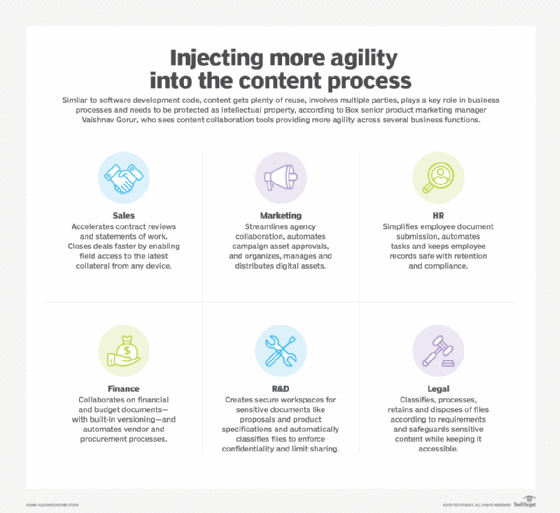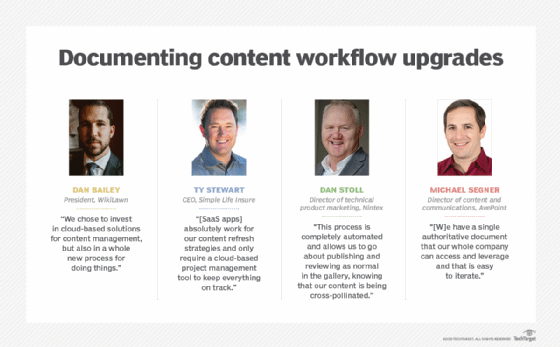Media workflow management takes a page from DevOps, Agile
Taking lessons from software development methods, agile content collaboration and management tools promote speed, flexibility and teamwork in digital media workflows.
Content collaboration technologies promise to improve employee productivity and customer engagements by enabling more flexible, effective and efficient media workflow management internally and externally.
But collaboration tools for storing and managing the content are only one part of the equation. Even though it's likely to complement productivity, project management and unified communication apps, collaboration will exist as a subset of content management rather than a standalone offering, said Nucleus Research analyst Evelyn McMullen. AI, machine learning and metadata, she added, will be key for streamlining processes and improving media workflow management.
Before considering the technologies, McMullen suggested that companies first identify the workflows, processes and outcomes that need to be managed and plan accordingly. "One challenge we see enterprises running into is immediate need for content management without any planning or strategy in place," she said.
And smooth workflows depend on teamwork. Agile methodologies in software development, for example, focus more on improving team coordination than streamlining the process. "As with DevOps and Agile, successful content management in my experience is less about technology and more about workflows and teamwork," explained Bob Gower, an Agile marketing coach and co-author of Radical Alignment. "The power of a flexible workflow is the ability to reflect and get better continuously. Teams and management need to embrace this, but it can feel a tad chaotic at times."

Simple multi-tenant editors like Google Docs form the baseline for collaboration by providing a non-destructive editing environment, so nothing is lost and there's no need for version control or email attachments. "I'm shocked at how many editors still send around Microsoft Word docs," said Gower. "It's so inefficient." Project-specific tools, he noted, can also help automate many aspects of the content management process.
While content management platforms take in media workflow management methods, they're nowhere near the level of software development practices. "Content management normally is a set-and-forget process in that people add content, content goes for review and content gets published," said Dan Stoll, director of technical product marketing at process management and workflow automation provider Nintex.
DevOps processes are characterized by ad hoc or short bursts of activities, requiring shared libraries and reusable components. Stoll believes that content collaboration tools will eventually get to the same place when automation complexity reaches the same level as it has for code. Until then, companies will have to create tools designed for specific purposes and applications.
Nintex, for example, has created a content platform that allows its sales teams to locate marketing material and price books based on criteria already set up in the CRM system. Using its own cloud automation service, the company can review and move content from a central gallery into the sales team's content platform. "This process is completely automated," Stoll explained, "and allows us to go about publishing and reviewing as normal in the gallery, knowing that our content is being cross-pollinated into other systems to increase visibility."

AI's infiltration into content
AI is beginning to play a significant role in content production for tasks like proofreading content or weeding out customer information, such as phone numbers and credit card details, that can't be published. AI could also scan existing documents for relevancy, revisions and updates.
"We're starting to see AI as the next big enabler as it helps automate and streamline workflows to reduce cost [and] increase efficiencies and productivity," said Greg Loose, head of media and entertainment at AI technology provider Veritone. And the cloud allows users to quickly adopt new collaborative content tools to meet changing management processes and workflows. AI, he explained, can automatically generate metadata for video and audio clips, which allows companies to find media assets and clips within seconds and quickly share, repurpose, license and further monetize content.
Loose also sees tailored applications of low-code AI technologies for intelligent process automation to augment existing workflows and enterprise applications. These apps can help automate language identification, entity extraction, sentiment analysis and scene detection. "AI is interwoven within other enabling technologies, such as on-demand media asset management platforms, making them and the assets themselves intelligent," he said.
The grass and content is now greener
Online lawn and garden resource WikiLawn lost an entire content database last year due to corrupted data. That disaster provided the impetus to overhaul existing collaborative content tools and processes, according to WikiLawn president Dan Bailey.
The old on-site ECM system made content searches difficult and slowed imports of website and social media content. "We chose to invest in cloud-based solutions for content management, but also in a whole new process for doing things," Bailey explained. The transition to SharePoint, which serves as both a content hub and management service, took about two weeks to assess their content storage and sharing needs, evaluate existing content and move everything. The database, he said, can now function in the cloud or on site, and it quickly stores, categorizes and searches content.
Despite the streamlined process, Bailey believes content management tools have a long way to go. "Content management services are focused more on access right now than seamless iteration, which is one of the main things we need." He'd like to see an all-in-one package that allows editing of different types of content and automatic saving that commits to online and local branches.
A new generation of internet marketers uses collaborative content management to enable faster iteration and reuse of content. "Getting to the best version of a piece of content is like iterating to the best version of a piece of code," said Nate Nead, CEO of SEO.co, an online digital marketing services company that uses online sharing and project management tools for weekly content scrum meetings to ensure that tasks are appropriately assigned.
"Being nimble is about having the right process coupled with the right tools," he reasoned. The company's team migrated from spreadsheets and Google Docs to the mobile and web app Asana for organizing, tracking and managing tasks and Slack for communications.
The COVID-19 effect
Companies that were toying with implementing content collaboration tools earlier this year had to accelerate their plans after COVID-19 drove their digital workers home. One company in particular actually saw a 400% spike in adopting Microsoft Teams and other collaborative content tools, according to Michael Segner, director of content and communications at AvePoint, which develops migration, backup and governance software for Microsoft 365.
Segner had been working on setting up a better media workflow management system out of frustration with the existing waterfall-type of linear sequential process in which one person writes a document, sends it to someone else for editing, who sends it to another person for approval. And if the edits overlap, versioning problems would ensue.
With Teams, Segner can upload a document to a specific channel that allows any number of members within the channel access to the document to do rewrites and edits in parallel. The approval process is much faster and, once approved, the document posts to a central "Go To Market" SharePoint site for public or internal-only viewing. "This way," Segner noted, "we have a single authoritative document that our whole company can access and leverage and that is easy to iterate."

Name that content
Software development has settled on two popular terms to describe faster, more flexible, collaborative lifecycles: DevOps and Agile. Content workflows lack a specific term to describe a similar move toward speed and agility, but there's no shortage of suggestions.
Gartner has proposed the term new work nucleus as content management tools evolve away from the traditional. In this framework, content collaboration platforms are replacing enterprise file synchronization and sharing (EFSS), workstream collaboration is replacing unified communications and collaborative work management is replacing traditional project management tools like spreadsheets.
Nucleus Research's McMullen believes intelligent information management extends beyond traditional content services. Nintex's Stoll suggested content automation to encompass the use of AI technologies to move content through the various phases of production and distribution.
Veritone's Loose said intelligent content aptly describes the streamlining of the content development and deployment lifecycle. "This means that all content is supported by AI through metadata and workflows to create more engaging results and ultimately drive revenue," he explained.
Simplifying content collaboration
Insurance broker Simple Life Insure in San Diego has been experimenting with collaborative content tools to share and update written policies and underwriting documents between their team and clients and to improve the educational content published on its website, according to CEO Ty Stewart. He needed to address the company's content repository when Google algorithm updates changed how content was ranked by the search engine. The content also had to be refreshed regularly.
"In our industry," Stewart said, "making those timely updates is pivotal since information needs to be accurate, given changing regulations in the finance and insurance world, which happens annually." Rather than create homegrown software, he opted for SaaS applications.
Simple Life uses BuzzSumo for trending industry topics and emerging long-tail keywords to include in new content as well as to restructure and revitalize old content. The company uses Trello to manage workflows in the content development and deployment process, including tasks like finding and drafting an SEO revitalized outline, writing changes and monitoring updated content performance. Cloud-based project management tools monitor these tasks and move them on to the next person.
These workflows might not exactly mirror the DevOps and Agile software development processes used for code, Stewart noted, but "they absolutely work for our content refresh strategies and only require a cloud-based project management tool to keep everything on track."
Venkat Ramasamy, COO and vice president of marketing at cloud-agnostic EFSS provider FileCloud, prefers content as a service. "The key enabling technologies," he said, "are metadata integration, smart classification, powerful search, indexing, flexible APIs, workflows and cloud-agnostic open systems."
Vaishnav Gorur, senior product marketing manager at Box, said cloud content management addresses how content is managed, protected, governed and used internally and outside an organization. That entails file organization, sharing, storage and access; permission control; and collaborative workflow.
There's no shortage of terms to describe media workflow management, but the suggestion box is not quite full as yet.








